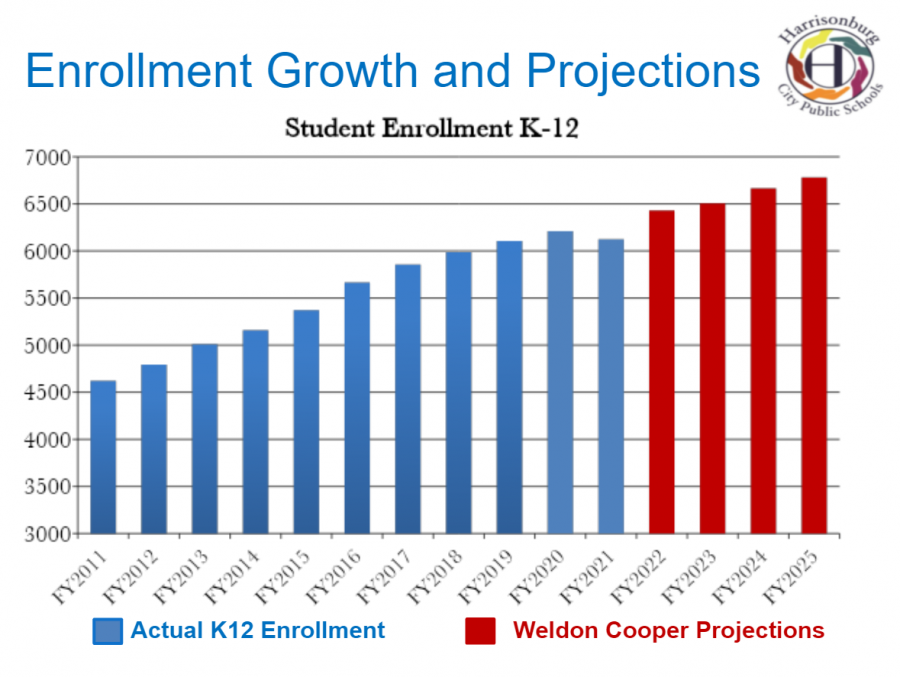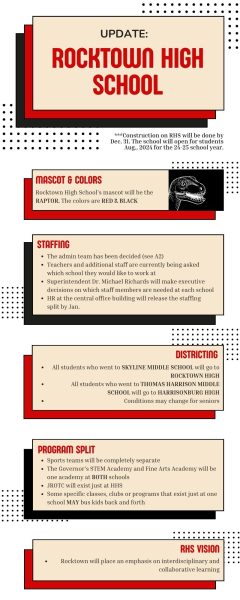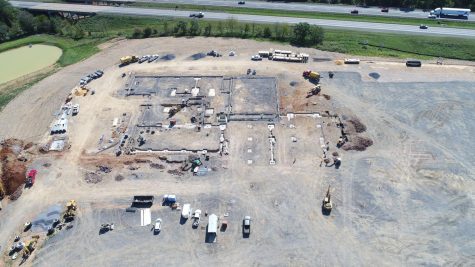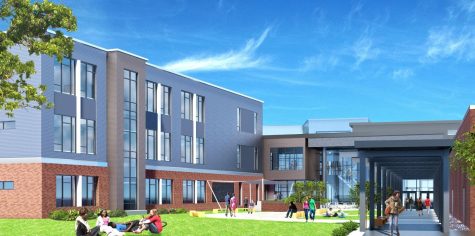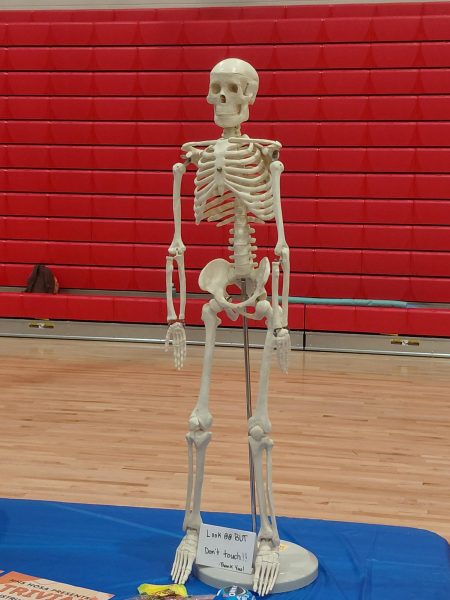HHS2 advocates speak up for new high school to be built
Used with permission by Michael Richards
Harrisonburg High School is currently home to 1859 students. Overcrowding has been an issue for the school over the past few years and the Weldon Cooper Center for Public Service projects that the city schools will continue to see an increase of students in the coming years.
At the April 13 City-School Liaison Committee meeting, Harrisonburg public officials met to discuss the proposed budget for the 2021-2022 year. At the meeting, one of the biggest questions was whether or not the city would provide funds to restart the build of the second high school in Harrisonburg. Currently, the city has not allocated any money in the budget to fund the build. The project was originally on track to finish in the spring of 2022, allowing the school to open later that fall; however, after having to delay construction due to the COVID-19 pandemic, members of the ForHHS2 advocate group are worried that the lack of funding will cause the new high school to be delayed even further while overcrowding issues in the city continue to grow. The group is run by Barbrara Reisner, Adrienne Hooker, Becky Deloney and Cathy Copeland.
“[The new high school] has been on our radar for quite a while, and we were all right there at the groundbreaking. [We were] super relieved that progress [was happening], literally dirt was being moved, and then when COVID hit, we completely understood the pause [in construction] because we knew we had bigger fish to fry,” Hooker said. “I think [our hope was that when] things started getting back online and the economy [started] to move, that the second high school [would be put] back into that budget. This is a critical moment to start being vocal again.”
Originally started in 2017, the ForHHS2 group works as an information hub and advocate group for families of Harrisonburg City Public Schools (HCPS) students to help them understand the significance of building a second high school.
“What we saw back in [the] summer of 2017 was a culture of ambiguity within how people approach the information that the city was giving to us. We needed to show a step-by-step process for who makes the decisions and when so that we could connect to the people who needed to know where the community stood on this. What we developed through several years was a central place [for] information. People need to know who’s making these decisions because there are a lot of people in trouble, and we need to figure out where the money can go to be of most value,” Copeland said.
Over the years, the group has struggled to gain the needed support from the community due to the constant changeover of who will be affected by the new high school.
“The predicament is [that it is] a constant changeover, and the people that it affects are not activated because [the new high school opening] is so far down the road that they do not see it personally being a part of their lives. It is really hard to keep the voice constant and the advocacy going because everyone is cycling through. I understand the fear of when we did pause [due to COVID] because it took so long to get that motion happening,” Hooker said.
Not only does the ForHHS2 advocacy group feel that the community needs to be more invested in the project, but since Reisner is the parent of a current high schooler, she is also reaching a point where the project will not affect her own family. She can relate to the lack of motivation from other current high schoolers and their families.
“As the parent of a tenth grader who will never attend a new high school, I am a little bit checked out at the point where it is useful to have people with younger kids who have more skin in the game, so to speak, staying on top of the facts,” Reisner said. “I feel like the city council does not see our entire community and see this as a priority. Obviously we see this as a priority, but I don’t know if the broader community is as invested in this.”
Funding
At the liaison committee meeting, instead of allocating current funds for the new high school build, the city proposed a six month hiatus of the build in order to prioritize other city needs and economic factors. HCPS superintendent Dr. Michael Richards understands that the city council has many things to allocate money towards, but he feels that a six month waiting period would be detrimental to students.
“My concern is that I do not want to wait six months. I think that the benchmarks proposed by the city are not complete in the sense that they take into account only when we may raise taxes and not other important factors such as the cost of borrowing and the fragile nature of the contract we are in with the builder. We are in a very good contract with Nielsen Builders, but it will need to be resuscitated,” Richards said.
Although the initial plan did not include any funds allocated toward the new high school, the city’s budget process is still in the works. Due to the economic barriers present in the city after the pandemic, the city is slated to receive money from the American Rescue Plan Act (ARPA), a federal act aimed at helping small communities get back on their feet post-pandemic. City council is currently going to receive approximately 13 million dollars that can be allocated where they see fit. The school system is also hoping to receive close to 9.5 million dollars that can be spent at Richard’ discretion.
“I told [city council] that I am willing to put 9 million dollars of the American Rescue Plan Act into restarting the new high school while the city council and the school board work out the taxing issue,” Richards said.
While Richards was not completely surprised by the lack of funding for the new school, he is disappointed that the city does not collectively see this as a pressing issue.
“I am disappointed because this project should be seen by the city as a top priority, and I got a sense [that it isn’t a necessity] from there being no reference of even potentially using ARPA money for the school. Instead, the narrative I am getting from them is that there are more important projects to do at this point, which is disappointing. HHS2 is a priority for the whole city; not just the school system, but everyone,” Richards said.
When the new high school building was paused in April of 2020, the city had to use approximately $600,000 to stabilize the project and preserve the land. Richards believes that if the city waits to resume building, the costs of materials will continue to rise, causing the need for even more funds to be allocated towards the project.
“[HHS2 construction] is very expensive to stall,” Richards said. “In addition, the cost of materials continues to rise because of [President] Biden’s infrastructure planning coming along. What is likely to happen is that there will be a lot of buildings all around the country, so the price of the basic materials will go really high. That is why we need to start building right away.”
Overcrowding at HHS
In the current city schools, overcrowding has been an issue for the past few years. Harrisonburg High School has gone over the 1300 student capacity and is currently home to 1859 students.
“There has been a huge lack of planning for the city’s growth. Now that Skyline [Middle School] and Thomas Harrison [Middle School] are back at capacity, I am sure that the elementary schools will be following close behind. I think that there is definitely a need for more schools, but we can’t even fix the high school situation,” Reisner said.
As the parent of an HHS sophomore, Hooker believes that the overcrowding issues at the current high school go beyond the lack of space, and have a detrimental impact on students’ education and high school experience as well.
“There are studies that show that not only academics suffer in an overcrowded school, but also bullying increases, so the pure safety of the schools deteriorates. We need people to take the time to speak up about it. A lot of [the] time, it is lack of knowledge or lack of courage. I encourage that people don’t need to know everything, rather, they need to speak from their experiences,” Hooker said. “They need to tell their city council and school board what is happening on a personal level. We want to call out [to] everyone that has a voice because everyone does. They don’t need to know the ins and outs; they just need to tell their story.”
Transitioning back in-person
The overcrowding situation at the HHS presents many problems for the school and the community, one key issue being how to get students back in-person by the fall of 2021. At the moment, select students have returned to in-person learning at the high school level while the majority still learn online. In Copeland’s opinion, the two situations are more related than most citizens realize.
“As much as we want to separate worrying about the future high schoolers from the current high schoolers, we can’t because they are all the kids of the community and they all matter. In this case, to build a high school, we have to talk to the city council. School board has said that they are willing to invest funds to restart the build, but the city council is not looking at the long-term significance of it. Community members get overwhelmed because the power that a city council member has is considerable because they are making a lot of decisions for the local community. I am sure they are overwhelmed with all of the multiple traumas they are dealing with, but that is why it is vital they hear from all walks of life,” Copeland said.
Deloney cannot see a solution to getting students safely back into the building anytime soon due to the students population growth projections for the next few years.
“The main reason that it is hard for me to imagine what can be done is because of the numbers. They reduced the social distancing guidelines from six to three feet, but even with the three feet apart, I don’t see how that’s possible to have the entire student body in the building at one time. Maybe vaccinations open up before fall to twelve to fifteen year olds, but it won’t be mandated. It’ll probably still be under emergency use authorization, and so you’re not going to be able to say that most students are vaccinated,” Deloney said.
In HCPS, kindergarten through eighth grade students returned to the classroom April 26, 2021, per Governor Northam’s mandate that all school districts must offer in-person learning to all students by the fall. Richards plans to comply with this order and introduce a plan to the school board for return during the May school board meeting.
“What will be important to address is the common areas and dining areas because those are where students congregate. We have started to look at the way scheduling is done to figure out how to get more space to get students back. I will be introducing my plan of how to expand those common areas to the May meeting, [but] I plan to have kids back in school five days a week. I imagine some schedules will have to be staggered, but still, every student will have the opportunity to be in-person five days a week,” Richards said.
As a teacher, Copeland understands first hand the difficulties and the mental health concerns that come with learning online. Copeland believes that when Northam presented the law that required all students to return in the fall, the delegates and senators did not think of the implications this law would have for communities such as Harrisonburg.
“When a law like that comes up, it typically gets a huge pass rate in the general assembly which means our delegates and state senators both voted for it and did not specify any difficulties within it, only positives with having kids come back to school. As a teacher myself, I recognize the difficulties of digital learning, but the safety of digital learning cannot be compared to an in-person situation. I was disappointed that [nobody] brought up an important aspect of how their area would not be able to comply with this and work around it,” Copeland said.
Moving forward
After a few years of pushing for a second high school, the ForHHS2 group feels that the city could have done more to prepare for the overcrowding issues.
“I think that there is a history of being reactive instead of proactive. [The city] has always done just enough to hit what was needed instead of budgeting, saving and planning ahead. I don’t know why people don’t believe the projections because so far when you look, they have been right on,” Hooker said. “This group knew very early on that the second high school is just the tip of the iceberg. We have to be proactive and we haven’t been, so it’s hard to get people to make the switch from survival mode to focusing on the future to make something better.”
To make this push, Reisner and the group believe that community members need to use their platforms to speak from their own experience to advocate for their education.
“[Our main goal is] advocating that every student in this city should get a public education in a safe environment. Our big focus is seeing that eventually we get another high school, but also what happens next year is important. We see all of the other schools going back, but the overcrowding presents such a challenge,” Reisner said. “Those personal stories are so important and compelling. Hearing the voices of the people who experience this and how it impacts them is a really powerful message.”
One of Richards’ main concerns is that if the city moves forward with the six month waiting period, the opening of the new high school could be delayed indefinitely.
“It is not a linear equation or a one to one relationship. In other words, if we don’t start talking about funding until six months from now, then that pushes the opening of the school longer than six months, especially if we have to get a new contract with a builder. Then at that point, you could add another year to the process,” Richards said.
Moving forward, Copeland believes that the city needs to rework their budget to immediately allocate funds for the construction of the new school.
“I think that city council should pay for the restart of HHS2 so that the money that the school board intends to invest in the build restarting could be used to fund expansion strategies. I think that because city council is being overloaded with the fact that their money has to be used, they are not going to be able to figure out how to fix this,” Copeland said. “I think that we need to give them that grace period to figure out how to spend all of that money to find some necessary solutions.”
As for Deloney, educating the public about what they can do is one of her top priorities so that they can help to advocate for the building to resume.
“Moving forward, we need to continue to educate the public and get the word out. Council has said that they need to hear other voices of people who have struggled through the pandemic and been affected by trauma to convince them that education is something that they should prioritize in our city to alleviate the overcrowding,” Deloney said.
Although the ForHHS2 group is asking community members to trust that, by sharing their stories, city council will listen and respond appropriately, they acknowledge that finding that trust is sometimes difficult.
“I think that it is difficult to trust politics, but it doesn’t have to be, especially at the local levels because they are members of our community. That trust can enrich our lives if we can have a great relationship. It will make us see the value that being a community and working together [has and] can find the best interest of all people to be a healthier city. We need to have the freedom to express our views and we want everyone to do so,” Copeland said. “If we want the change we are striving for, we have to do the uncomfortable things and share those personal stories to achieve what we want.”
The group plans to focus on empowering the families of middle and elementary school students as the new high school will be more important for them than the current students by the time the school is opened.
“We need a broad cross section of the community to speak up and realize that this is going to impact their fifth graders, sixth graders [and] maybe even fourth graders. I think that it is really hard to look out that far and understand the impact that the environment has on students,” Reisner said.
Down the road, Hooker is concerned that if the overcrowding issues aren’t addressed now, they will have a lasting impact on students’ education and the community.
“If you don’t have proper public education, then you aren’t raising the citizens you need to continue the population and continue the economy. I think that so many in the community are hopeless, especially after 2020, that we can’t even imagine anymore being in a place where we can thrive,” Hooker said.
In addition to the ForHHS2 group encouraging citizens to speak up, Richards also believes that by speaking to local officials and sharing personal stories, the community can push to resume building as soon as possible.
“I always recommended that, in a representative democracy, people reach out and speak to their elected officials. I hope people keep it civil, but I think that they should reach out and talk to our officials. I hope that the school board members and council members let their voices be heard. Keep in mind that the city council members are trying very hard to make this happen. Those voices are very important to keep reminding [the officials] because this is a top priority,” Richards said.
In the future, Richards is hopeful that current HHS students will be back in-person in the fall as well as that the construction of the new high school will be resumed to offer a better education for future students.
“I am optimistic that we will get [the new high school] done,” Richards said. “There is quite a bit of adversity, but we will get it done.”
Your donation will support the student journalists of Harrisonburg High School. Your contribution will allow us to purchase equipment and cover our annual website hosting costs.




